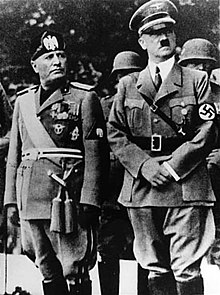
Back الفاشية في أوروبا Arabic פשיזם באירופה HE Nazismo na Europa Portuguese Fascism în Europa Romanian Avrupa'da faşizm Turkish

| Part of a series on |
| Fascism |
|---|
 |
Fascist movements in Europe were the set of various fascist ideologies which were practiced by governments and political organizations in Europe during the 20th century. Fascism was born in Italy following World War I, and other fascist movements, influenced by Italian Fascism, subsequently emerged across Europe. Among the political doctrines which are identified as ideological origins of fascism in Europe are the combining of a traditional national unity and revolutionary anti-democratic rhetoric which was espoused by the integral nationalist Charles Maurras[1] and the revolutionary syndicalist Georges Sorel.
The earliest foundations of fascism in practice can be seen in the Italian Regency of Carnaro,[2] led by the Italian nationalist Gabriele D'Annunzio, many of whose politics and aesthetics were subsequently used by Benito Mussolini and his Italian Fasces of Combat which Mussolini had founded as the Fasces of Revolutionary Action in 1914. Despite the fact that its members referred to themselves as "fascists", the ideology was based around national syndicalism.[3] The ideology of fascism would not fully develop until 1921, when Mussolini transformed his movement into the National Fascist Party, which then in 1923 incorporated the Italian Nationalist Association. The INA established fascist tropes such as colored shirt uniforms and also received the support of important proto-fascists like D'Annunzio and nationalist intellectual Enrico Corradini.
The first declaration of the political stance of fascism was the Fascist Manifesto, written by national syndicalist Alceste De Ambris and futurist poet Filippo Tommaso Marinetti and published in 1919. Many of the policies advanced in the manifesto, such as centralization, abolition of the senate, formation of national councils loyal to the state, expanded military power, and support for militias (Blackshirts, for example) were adopted by Mussolini's regime, while other calls such as universal suffrage and a peaceful foreign policy[4] were abandoned. De Ambris later became a prominent anti-fascist. In 1932, "The Doctrine of Fascism", an essay by Mussolini and Giovanni Gentile, provided an outline of fascism that better represented Mussolini's regime.
- ^ Carroll, David (21 July 1998). French Literary Fascism. Princeton University Press. ISBN 9780691058467.
- ^ Sternhell, Zeev; Sznajder, Mario; Ashéri, Maia (8 August 1994). The Birth of Fascist Ideology: From Cultural Rebellion to Political Revolution. Princeton University Press. ISBN 9780691044866 – via Internet Archive.
- ^ James Gregor, A. (13 August 2006). Mussolini's Intellectuals. Princeton University Press. ISBN 9780691127903.
- ^ "Tiscali Webspace". webspace.tiscali.it.
© MMXXIII Rich X Search. We shall prevail. All rights reserved. Rich X Search